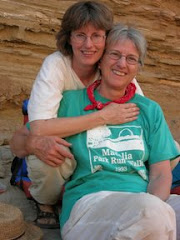 Last year at the Midwest Independent Publishers Association Book Awards ceremony, Living Consciously, Dying Gracefully won first place in the Health category. After accepting our award in front of 300 publishers, booksellers, and authors and getting gold stickers for our books, Nancy and I were given the envelope of scoring sheets and comments from the judges. Our mouths dropped open when we read, "This book deserves a mainstream publisher and a national audience."
Last year at the Midwest Independent Publishers Association Book Awards ceremony, Living Consciously, Dying Gracefully won first place in the Health category. After accepting our award in front of 300 publishers, booksellers, and authors and getting gold stickers for our books, Nancy and I were given the envelope of scoring sheets and comments from the judges. Our mouths dropped open when we read, "This book deserves a mainstream publisher and a national audience."We hadn't considered going mainstream, but the judge's comment was a catalyst. We didn't do anything for a while, but then our friend Mary Treacy O'Keefe, author of Thin Places (also published by Beaver's Pond Press), started nudging us: Find an agent! You need to get to a big publisher! Find an agent! Call Larry Dossey and ask him who his agent is!
 Eventually we contacted Larry Dossey, M.D., who had already written a beautiful blurb for our back cover, and he recommended a literary agent in northern California --Barbara Deal, owner of Literary Associates. Although she wasn't taking on any new projects, once she read Living Consciously, Dying Gracefully, she agreed to take us on.
Eventually we contacted Larry Dossey, M.D., who had already written a beautiful blurb for our back cover, and he recommended a literary agent in northern California --Barbara Deal, owner of Literary Associates. Although she wasn't taking on any new projects, once she read Living Consciously, Dying Gracefully, she agreed to take us on.We've been waiting out the economic crisis, but now that publishers are again buying manuscripts, Barbara thinks the time is right. So we wrote a book proposal for her to present to publishing houses. By the time we finished this 30-page description of our book, the market, the competition, and our passion for sharing Diane's story, even WE were impressed!
Last week, ten packets went out to ten publishers. If one of them likes the book, there could be a revised, expanded edition published by this time next year. We're keeping our fingers crossed. We hope that Diane's inspiring story can take the next step in reaching a much wider audience!




